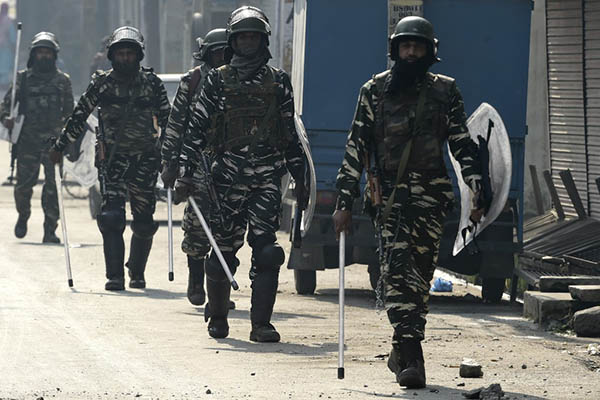
Indian paramilitary troopers patrol along a street during a lockdown in Srinagar. Tauseef Mustafa—AFP
In Indian-occupied Kashmir, basic rights and cultural practices are denied while religious scholars, journalists, and social activists are kept under detention without any evidence. At the same time Indian forces march on the streets, making it the most militarized region in the subcontinent. Yet the hearts and minds of the people are being wooed with the opening of cinema halls, which the Kashmiris have rejected, their sole demand remaining the right to choose if they want to go on living under occupation and being treated differently from the rest of India. What is apparent is India’s policy of pushing back the distinct Kashmiri Muslim culture and identity to make space for Hindutva.
Mehbooba Mufti, former chief minister of Jammu and Kashmir, has asked the international community to take a look at the forced singing of bhajan (Hindu hymn) in schools. Videos of Muslim students singing the bhajan are circulating on social media with Muslims protesting the act. The past has been no different. Late American scholar Stephen P. Cohen, hailed for producing a remarkable survey of the “Kashmir problem,” noted that the people who oversaw the distribution of territories at Partition failed to plan for the integration of Kashmir in the new two-state order, leaving both Pakistan and India with the impression that an injustice had been committed. Kashmir then came to play a role in the domestic politics of both states; For Pakistani leaders—civilian and military alike—Kashmir was a helpful diversion from the daunting task of nation-building. Significantly, powerful Kashmiri-dominated constituencies also have a voice in major Pakistani cities. Even abroad, there have been strong Kashmir lobbies in some European states, especially in a few British cities with large numbers of Kashmiri or Mirpuri migrants. Pakistan has suffered in measure with the Kashmiris who have to live in Indian-occupied Kashmir.
Pakistan and India have fought wars over the disputed region without recognizing the real losses incurred because of the unresolved Kashmir issue. Over the years many solutions have been proposed, but an ultimate solution remains out of reach because of at least three factors. First, the cold war, which led both American and Soviet administrations to see this regional dispute not for what it was, but as part of the systemic East-West struggle. Second, both states have been inflexible where Kashmir is concerned; India’s strategy has been to erode Kashmir’s special status under an Article of its Constitution while also pretending that the problem was “solved” by the India-Pakistan Simla Agreement of 1972. This dual strategy of no change within Kashmir and discussion of it with Islamabad failed to prepare New Delhi for the unrest of the late 1980s.
India has already rejected any political option to resolve the Kashmir problem; rebuffed a strategy of accommodating Kashmiri demands; excluded Pakistan from its Kashmir policy; and stubbornly opposed outside efforts to mediate the dispute. Meanwhile, the seemingly well-intentioned proposal for Kashmiris to be “consulted” or have a voice in determining their own fate has yet to gain much traction as it is threatening to both Islamabad and New Delhi.
